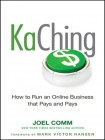KaChing: How to Run an Online Business that Pays and Pays Comm, Joel (books for 8th graders txt) 📖

Book online «KaChing: How to Run an Online Business that Pays and Pays Comm, Joel (books for 8th graders txt) 📖». Author Comm, Joel
7. MULTIMEDIA CONTENT
Most content on the Web is still text-based, but it’s become very easy now to post other forms of content. YouTube lets publishers embed its videos onto Web pages, and you can create your own clips and upload them to your site. Photos can also help attract viewers. If you don’t want to use your own images, you can pay a buck or so for the high-quality stock images in sites like iStockphoto.com and Fotolia.com or search for Creative Commons-licensed images on Flickr. Just make sure that you tick the box at the bottom of the search page so that you’re not breaching copyright. You’ll need to credit the photographer and link back to the Flickr page, but in return you’ll get a free visual illustration for your article.
Usually, multimedia content forms part of a web site—it’s extra content that puts across information in a way that complements the text—but it’s also possible to use multimedia as a replacement for text. My site ask.joelcomm.com contains nothing but clips of me answering questions posed by my users and talking directly to the camera (Figure 3.3). They’re incredibly fun to do, and you can make the process as simple or as complicated as you want. If you like messing around with editing software, then you can play at being Spielberg and have a blast. Or you can just sit in front of a video camera on a tripod—or even your webcam—shoot, and upload. It’s extra, original content in the space of about five minutes.
Those are just seven types of content that you can create for a web site. There are lots of others, but those seven should give you plenty to work with. If you’re ever stuck wondering what to post next—and that will happen!—coming back to one of these standard article types should help to break the block.
Figure 3.3Video content rules at ask.joelcomm.com. Do you see how I turned a how-to post into multimedia content? Serve your content in different formats and you’ll reach different types of users.
It’s Not Just What You Say, It’s How You Say It
So you can put information on your site in lots of different ways. That information will always be the most important aspect of your site, the reason that it will bring in users and succeed—or be ignored and fail. But style plays a role, too.
I’m not going to make too big a thing about this, because the easiest way to destroy any business is to be someone you’re not. Whether someone sees me on stage at a conference, tweets me on Twitter, reads my blog, or meets me face-to-face, they’re getting me. This is the way I am. Not everyone likes it. Some people think I’m too forthright in my views. That’s their opinion. I have mine, and I’m not going to try to be something I’m not just to please everyone. That’s the surest way to please no one.
When you’re creating content for your web site, give it your voice. Don’t try to write as though you’re creating an article for Fox News or hoping to sell it to Cosmopolitan. Picture your best friend in the room with you, and write as though you’re explaining what you want to say to him or her. Informality might look strange in the New York Times, but it works great on the Web.
That doesn’t mean you shouldn’t plan what you’re going to say. You should still do that. But you should write the way you speak. It’s the easiest way to make sure that your site carries your voice and personality and that the content is clear.
Once you’ve written the article, put it to one side, then go over it before you post. Look for typos, run it through a spell-check, and delete any repetitions. They can make an important difference to the flow. There’s a reason reporters will write “Steve Jobs” in one sentence and “the CEO of Apple” in the next. When they repeat the same phrase again and again, the article becomes difficult to read. You want to make the passage as smooth as possible, from beginning to ad click to KaChing.
Ghost and Guest Writers
When you build your first web site, it’s likely that you’ll be doing most things by yourself. You’ll be playing with the designs, bringing in users, and writing the content. That’s probably the best way to begin. It might take you a little longer to get rolling, but nothing beats hands-on experience. As you grow, you’ll start to look for help, and part of that help can come in the form of writers.
You might find that this happens by itself. When your site becomes well known, other people in your field will ask whether they can put articles on your site. You won’t usually have to pay them. They’ll get value from the exposure. While that can be good, free content, do make sure that the content is high enough quality. If you lose readers by posting something that’s little more than an ad, you’ll pay dearly for that post.
You can also hire writers. This is harder than it sounds. The Web is filled with people who think they can write but who actually struggle to complete sentences. You want people you can rely on to produce the content you want, on the topics you want, at the times you want, and at the level of quality you need. Elance.com is one place to look, although it can be pretty hit-and-miss. The feedback ratings should help to reduce the odds of picking a clunker, but don’t be afraid to test-drive a few writers and choose the ones you like the best. Alternatively, Scribat.com is a new service that works as both a syndication service and writing agency. You can buy off-the-shelf articles for a set rate, or you can ask the company to commission content for you, in which





Comments (0)